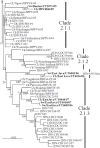A comparison of the pathogenicity of avian and swine H5N1 influenza viruses in Indonesia
- PMID: 19288052
- PMCID: PMC5785675
- DOI: 10.1007/s00705-009-0353-5
A comparison of the pathogenicity of avian and swine H5N1 influenza viruses in Indonesia
Abstract
Highly pathogenic avian influenza H5N1 viruses are circulating in many countries. We recently discovered that these viruses have been transmitted to pigs on multiple occasions in Indonesia. To investigate whether avian H5N1 influenza viruses adapted to mammals through their introduction into pigs, we examined the growth of avian and swine isolates in cell culture and compared their pathogenicity in mice. We found that swine isolates were less virulent to mice than avian isolates, suggesting that the viruses became attenuated during their replication in pigs. Continuous surveillance of H5N1 viruses among pigs is clearly warranted.
Figures

Similar articles
-
Influenza A (H5N1) viruses from pigs, Indonesia.Emerg Infect Dis. 2010 Oct;16(10):1515-23. doi: 10.3201/eid1610.100508. Emerg Infect Dis. 2010. PMID: 20875275 Free PMC article.
-
Evidence of infection with avian, human, and swine influenza viruses in pigs in Cairo, Egypt.Arch Virol. 2018 Feb;163(2):359-364. doi: 10.1007/s00705-017-3619-3. Epub 2017 Oct 26. Arch Virol. 2018. PMID: 29075888
-
An H5N1 highly pathogenic avian influenza virus isolated from a local tree sparrow in Indonesia.Microbiol Immunol. 2011 Sep;55(9):666-72. doi: 10.1111/j.1348-0421.2011.00361.x. Microbiol Immunol. 2011. PMID: 21699556
-
Avian and swine influenza viruses: our current understanding of the zoonotic risk.Vet Res. 2007 Mar-Apr;38(2):243-60. doi: 10.1051/vetres:2006062. Epub 2007 Jan 25. Vet Res. 2007. PMID: 17257572 Review.
-
The global H5N1 influenza panzootic in mammals.Nature. 2025 Jan;637(8045):304-313. doi: 10.1038/s41586-024-08054-z. Epub 2024 Sep 24. Nature. 2025. PMID: 39317240 Review.
Cited by
-
The avian and mammalian host range of highly pathogenic avian H5N1 influenza.Virus Res. 2013 Dec 5;178(1):3-11. doi: 10.1016/j.virusres.2013.09.004. Epub 2013 Sep 8. Virus Res. 2013. PMID: 24025480 Free PMC article. Review.
-
Comparative pathogenesis of an avian H5N2 and a swine H1N1 influenza virus in pigs.PLoS One. 2009 Aug 17;4(8):e6662. doi: 10.1371/journal.pone.0006662. PLoS One. 2009. PMID: 19684857 Free PMC article.
-
Virulence and genetic compatibility of polymerase reassortant viruses derived from the pandemic (H1N1) 2009 influenza virus and circulating influenza A viruses.J Virol. 2011 Jul;85(13):6275-86. doi: 10.1128/JVI.02125-10. Epub 2011 Apr 20. J Virol. 2011. PMID: 21507962 Free PMC article.
-
Kinetics of neutralizing antibodies in patients naturally infected by H5N1 virus.PLoS One. 2010 May 27;5(5):e10864. doi: 10.1371/journal.pone.0010864. PLoS One. 2010. PMID: 20532246 Free PMC article.
-
Avian Influenza A Viruses: Evolution and Zoonotic Infection.Semin Respir Crit Care Med. 2016 Aug;37(4):501-11. doi: 10.1055/s-0036-1584953. Epub 2016 Aug 3. Semin Respir Crit Care Med. 2016. PMID: 27486732 Free PMC article. Review.
References
-
- Xu X, Subbarao K, Cox NJ, et al. Genetic characterization of the pathogenic influenza A/Goose/Guangdong/1/96 (H5N1) virus: Similarity of its hemagglutinin gene to those of H5N1 viruses from the 1997 outbreaks in Hong Kong. Virology. 1999;261:15–19. - PubMed
-
- Li KS, Guan Y, Wang J, et al. Genesis of a highly pathogenic and potentially pandemic H5N1 influenza virus in eastern Asia. Nature. 2004;430:209–213. - PubMed
-
- Chen H, Smith GJD, Zhang SY, et al. H5N1 virus outbreak in migratory waterfowl. Nature. 2005;436:191–192. - PubMed
-
- WHO. Cumulative number of confirmed human cases of avian influenza A/ (H5N1) reported to WHO. 2008 Available at; http://www.who.int/csr/disease/avian_influenza/country/cases_table_2008_.... Accessed 24 Dec 2008.
-
- OIE. Update on highly pathogenic avian influenza in animals (Type H5 and H7) 2006 Available at; http://www.oie.int/downld/AVIAN%20INFLUENZA/A2006_AI.php. Accessed 24 Dec 2008.
Publication types
MeSH terms
Substances
Grants and funding
LinkOut - more resources
Full Text Sources
Medical

